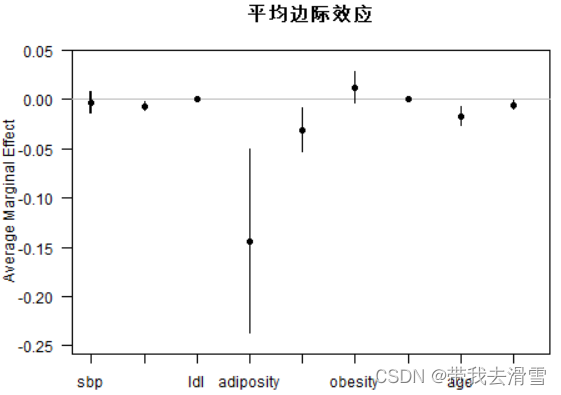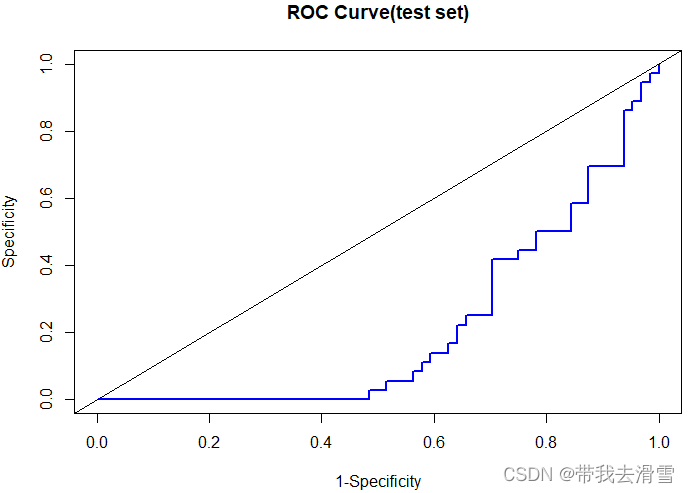- node.js 常用命令71条详解
- 开源浏览器Firefox:使用Docker本地部署并远程访问进行测试
- 学习使用在mysql中查询指定字段字符串包含多个字符串的方法
- Spring Cloud LoadBalancer 负载均衡策略与缓存
- 二刷大数据(一)- Hadoop
- 【mysql】mysql命令使用大全,你想要的都在这里
- Python 操作 MySQL 的5种方式
- Nginx安装(最全教程)
- 一文详解SpringBoot 定时任务(cron表达式)
- 【Rust】——项目实例:——命令行实例(一)
- Hbase解决ERROR: KeeperErrorCode = Con
- nginx-图片模块
- 使用 Python 连接到 PostgreSQL 数据库
- 【MySQL】学习和总结使用列子查询查询员工工资信息
- MySQL-视图:视图概述、创建、查看、更新、修改、删除
- JavaWeb项目:航班信息管理系统(tomcat+jsp)
- Springboot JPA打印SQL语句及参数(2024最新版)
- 【MySQL】MySQL中查询JSON字段的实战指南
- 图论(算法竞赛、蓝桥杯)--Dijkstra算法最短路
- Vue3 + Django 前后端分离项目实现密码认证登录
- IntelliJ IDEA 2023.3 的 AI Assistant
- 首游南京,AI科技大事件分享:百度智能云宣布国内首家支持Llama3全
- FlexLua:简化开发的LoRa无线氨气传感器技术
- Spring Boot集成knife4j
- 基于springboot的酒店管理系统论文
- visual studio配置node.js开发(完整版)
- 如何在 Ubuntu 14.04 上为 Nginx 添加 gzip 模
- 如何借助Idea创建多模块的SpringBoot项目
- Node Version Manager(nvm):轻松管理 Node
- RabbitMQ与RocketMQ:消息队列的两大强者对比
大家好,我是带我去滑雪!
本期使用R包 ElemStatLearn 的南非心脏病数据 SAheart 进行逻辑回归。其中,响应变量为chd(是否有冠心病,即coronary heart disease)。特征向量包括sbp(收缩压,systolic blood pressure)、tobacco(累计抽烟量)、ldl(低密度脂蛋白胆固醇,即low density lipoprotein cholesterol)、因子变量famhist(是否有家族心脏病史)、typea(A型行为,即type-A behavior)、alcohol(当前饮酒量)、age(发病时年龄),以及两个关于肥胖程度的数值型度量adiposity与obesity。该案例来自陈强编著的《机器学习及R运用》第5.1节课后习题。
需要完成的工作有如下:
(1)将响应变量 cha 设为因子变量,并计算样本中有冠心病的比例;
(2)使用set. seed (1),预留 100 个观测值作为测试集;
(3)使用训练集,将chd 对其余变量进行逻辑回归;
(4)计算此逻辑回归的准 ;
;
(5) 计算平均边际效应AME,并画图展示;
(6)在测试集中进行预测,计算准确率、错误率、灵敏度、特异度与召回率;
(7)画ROC 曲线;
(8)计算 AUC:
(9)计算 kappa 值。
(0)加载包
首先尝试最常用的先安装包再加载数据集:
> install.packages(ElemStatLearn)
Error in install.packages : object 'ElemStatLearn' not found
结果显示:“Error in install.packages : object 'ElemStatLearn' not found”,所以采用这种方法安装ElemStatLearn包不行,正确的做法如下,使用“str()”查看数据结构:
>packageurl <- "https://cran.r-project.org/src/contrib/Archive/ElemStatLearn/ElemStatLearn_2015.6.26.tar.gz"
>install.packages(packageurl, repos=NULL, type="source")
>library(ElemStatLearn)
>str(SAheart)
'data.frame': 462 obs. of 10 variables:
$ sbp : int 160 144 118 170 134 132 142 114 114 132 ...
$ tobacco : num 12 0.01 0.08 7.5 13.6 6.2 4.05 4.08 0 0 ...
$ ldl : num 5.73 4.41 3.48 6.41 3.5 6.47 3.38 4.59 3.83 5.8 ...
$ adiposity : num 23.1 28.6 32.3 38 27.8 ...
$ famhist : Factor w/ 2 levels "Absent","Present": 2 1 2 2 2 2 1 2 2 2 ...
$ typea : int 49 55 52 51 60 62 59 62 49 69 ...
$ obesity : num 25.3 28.9 29.1 32 26 ...
$ alcohol : num 97.2 2.06 3.81 24.26 57.34 ...
$ age : int 52 63 46 58 49 45 38 58 29 53 ...
$ chd : int 1 1 0 1 1 0 0 1 0 1 ...
(1)将响应变量 cha 设为因子变量,并计算样本中有冠心病的比例
> SAheart$chd=factor(SAheart$chd,levels = c("1","0"),labels=c("Have","Don't have"))
> options(digits = 4)
> prop.table(table(SAheart$chd))
Have Don't have
0.3463 0.6536
结果显示,样本中有冠心病的比例为34.63%,没有冠心病的比例为65.36%,其中“options(digits = 4)”表示保留小数点后四位数字。
(2)使用set. seed (1),预留 100 个观测值作为测试集
> set.seed(1)
> train_index=sample(462,362)
> train=SAheart[train_index,]
> test=SAheart[-train_index,]
> str(train)
'data.frame': 362 obs. of 10 variables:
$ sbp : int 140 110 134 176 132 136 150 150 128 174 ...
$ tobacco : num 8.6 12.2 8.8 0 12 ...
$ ldl : num 3.9 4.99 7.41 3.14 4.51 7.84 6.4 5.04 2.43 6.57 ...
$ adiposity: num 32.2 28.6 26.8 31 21.9 ...
$ famhist : Factor w/ 2 levels "Absent","Present": 2 1 1 2 1 2 1 2 2 2 ...
$ typea : int 52 44 35 45 61 58 53 60 63 50 ...
$ obesity : num 28.5 27.1 29.4 30.2 26.1 ...
$ alcohol : num 11.11 21.6 29.52 4.63 64.8 ...
$ age : int 64 55 60 45 46 45 63 45 17 64 ...
$ chd : Factor w/ 2 levels "Have","Don't have": 1 1 1 2 1 1 2 2 2 1 ...
(3)使用训练集,将chd 对其余变量进行逻辑回归
> options(digits=4)
> fit=glm(chd~.,data=train,family=binomial)
> summary(fit)
Call:
glm(formula = chd ~ ., family = binomial, data = train)
Deviance Residuals:
Min 1Q Median 3Q Max
-2.446 -0.871 0.456 0.786 1.887
Coefficients:
Estimate Std. Error z value Pr(>|z|)
(Intercept) 4.801815 1.464569 3.28 0.00104 **
sbp -0.001488 0.006739 -0.22 0.82528
tobacco -0.101163 0.029964 -3.38 0.00073 ***
ldl -0.181278 0.068809 -2.63 0.00843 **
adiposity -0.019735 0.032331 -0.61 0.54159
famhistPresent -0.801410 0.259376 -3.09 0.00200 **
typea -0.033687 0.013850 -2.43 0.01501 *
obesity 0.072542 0.048936 1.48 0.13824
alcohol -0.000867 0.005118 -0.17 0.86540
age -0.041313 0.013358 -3.09 0.00198 **
---
Signif. codes: 0 ‘***’ 0.001 ‘**’ 0.01 ‘*’ 0.05 ‘.’ 0.1 ‘ ’ 1
(Dispersion parameter for binomial family taken to be 1)
Null deviance: 465.32 on 361 degrees of freedom
Residual deviance: 369.50 on 352 degrees of freedom
AIC: 389.5
Number of Fisher Scoring iterations: 5
结果显示,经过5次“Fisher得分迭代”得到估计结果,其中,零偏离度(只有常数项模型的残差平方和)为465.32,而残差偏离度(完整模型的残差平方和)为369.50。
(4)计算此逻辑回归的准
> (fit$null.deviance-fit$deviance)/fit$null.deviance
[1] 0.2059
(5) 计算平均边际效应AME,并画图展示
>install.packages("margins")
> library(margins)
> effects=margins(fit)
> summary(effects)
factor AME SE z p lower upper
adiposity -0.0033 0.0055 -0.6116 0.5408 -0.0141 0.0074
age -0.0070 0.0022 -3.2198 0.0013 -0.0113 -0.0027
alcohol -0.0001 0.0009 -0.1695 0.8654 -0.0018 0.0016
famhistPresent -0.1436 0.0473 -3.0344 0.0024 -0.2363 -0.0508
ldl -0.0307 0.0113 -2.7307 0.0063 -0.0528 -0.0087
obesity 0.0123 0.0082 1.5007 0.1334 -0.0038 0.0284
sbp -0.0003 0.0011 -0.2208 0.8252 -0.0025 0.0020
tobacco -0.0171 0.0048 -3.5966 0.0003 -0.0265 -0.0078
typea -0.0057 0.0023 -2.4994 0.0124 -0.0102 -0.0012
> win.graph(width=5, height=4,pointsize=9)
> plot(effects,main="平均边际效应")
(6)在测试集中进行预测,计算准确率、错误率、灵敏度、特异度与召回率
首先,使用逻辑模型的回归结果进行预测,并计算混淆矩阵,使用测试集进行预测:
> prob_test=predict(fit,type="response",newdata=test)
> prob_test=prob_test>0.5
> table=table(predicted=prob_test,Actual=test$chd)
> table
Actual
predicted Have Don't have
FALSE 18 10
TRUE 18 54
其中,函数predict ()的参数“type = "response"”,表示预测事件发生的条件概率,根据此概率是否大于0.5,预测结果变量的类别。
根据混淆矩阵,可计算衡量预测优良程度的相应指标,包括准确率、错误率、灵敏度、特异度与召回率:
> (Accuracy=(table[1,1]+table[2,2])/sum(table))
[1] 0.72
> (Error_rate=(table[2,1]+table[1,2])/sum(table))
[1] 0.28
> (Sensitivity=table[2,2]/(table[1,2]+table[2,2]))
[1] 0.8438
> (Specificity=table[1,1]/(table[1,1]+table[2,1]))
[1] 0.5
> (Recall=table[2,2]/(table[2,1]+table[2,2]))
[1] 0.75
(7)画ROC 曲线
> install.packages("ROCR")
> library(ROCR)
> pred_object=prediction(prob_test,test$chd)
> perf=performance(pred_object,measure="tpr",x.measure="fpr")
> plot(perf,main="ROC Curve(test set)",lwd=2,col="blue",xlab="1-Specificity",ylab="Specificity")
> abline(0,1)
(8)计算 AUC
>aut_test=performance(pred_object,measure="auc")
>auc_test@y.values
[1] 0.2122
结果显示,曲线下面积为0.2122。
(9)计算 kappa 值
> install.packages("vcd")
> library(vcd)
> Kappa(table)
value ASE z Pr(>|z|)
Unweighted 0.361 0.0973 3.71 0.000205
Weighted 0.361 0.0973 3.71 0.000205
结果显示,在测试集中,kappa值为0.361,表明预测值与实际值之间具有中等一致性。
更多优质内容持续发布中,请移步主页查看。
若有问题可邮箱联系:1736732074@qq.com
博主的WeChat:TCB1736732074
点赞+关注,下次不迷路!
上一篇:【算法专题】滑动窗口
















